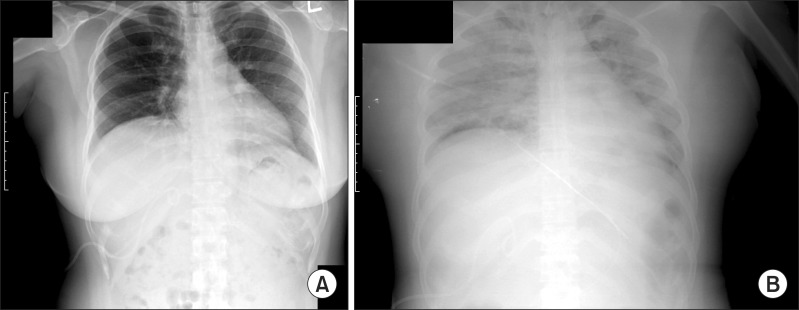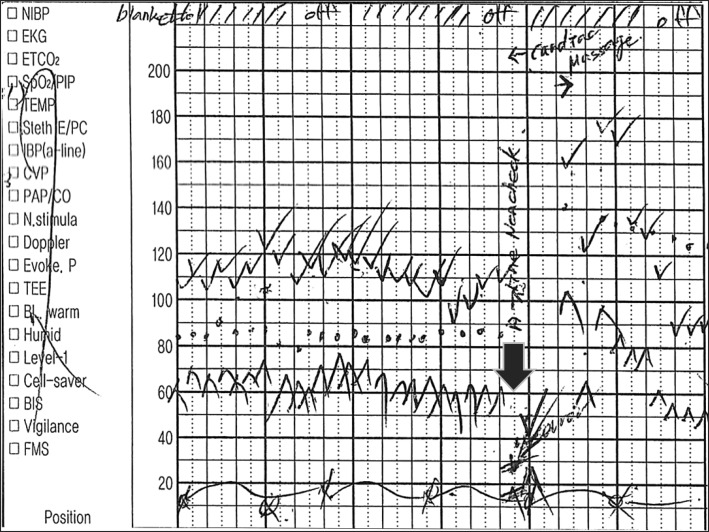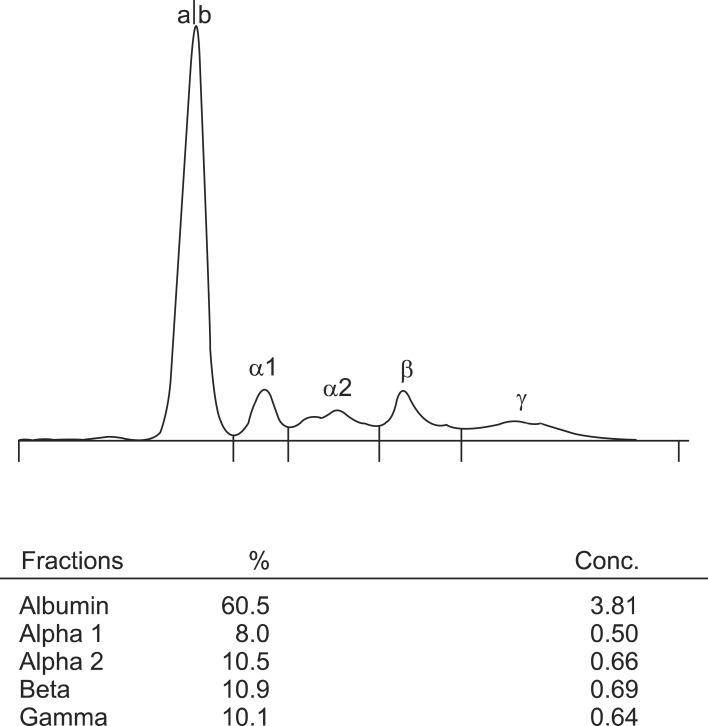Korean J Hepatobiliary Pancreat Surg.
2014 Feb;18(1):38-41. 10.14701/kjhbps.2014.18.1.38.
Systemic capillary leak syndrome (Clarkson's disease) during elective pylorus-preserving pancreaticoduodenectomy: case report
- Affiliations
-
- 1Department of Surgery, Gangneung Asan Hospital, University of Ulsan College of Medicine, Gangneung, Korea. goodnews@gnah.co.kr
- 2Department of Internal Medicine, Gangneung Asan Hospital, University of Ulsan College of Medicine, Gangneung, Korea.
- KMID: 1890080
- DOI: http://doi.org/10.14701/kjhbps.2014.18.1.38
Abstract
- Systemic capillary leak syndrome (SCLS), also called Clarkson's disease is rare and life-threatening disorder of unknown etiology, which is a characteristic triad of hypovolemic shock, hemoconcentration, and hypoalbuminemia. Unexplained capillary leakage from the intravascular to the interstitial space, which has been estimated up to 70% of the intravascular volume, is the proposed mechanism. Because the pathogenesis is unknown, it is diagnosed clinically after exclusion of other diseases that cause systemic capillary leak and no efficacious pharmacological treatment has been clearly established. The mortality rate ranges from 30% to 76%. In Korea, four cases of SCLS (5 cases in adult and 1 case in child) were reported by 2012. We describe a case of severe SCLS that suddenly occurred and rapidly progressed during pylorus preserving pancreaticoduodenectomy and review the literature.
MeSH Terms
Figure
Reference
-
1. Clarkson B, Thompson D, Horwith M, et al. Cyclical edema and shock due to increased capillary permeability. Am J Med. 1960; 29:193–216. PMID: 13693909.
Article2. Dhir V, Arya V, Malav IC, et al. Idiopathic systemic capillary leak syndrome (SCLS): case report and systematic review of cases reported in the last 16 years. Intern Med. 2007; 46:899–904. PMID: 17575386.3. Druey KM, Greipp PR. Narrative review: the systemic capillary leak syndrome. Ann Intern Med. 2010; 153:90–98. PMID: 20643990.
Article4. Lee TY, Chung YM, Kang HG, et al. A case of systemic capillary leak syndrome in a child. J Korean Pediatr Soc. 2002; 45:1298–1301.5. Chihara R, Nakamoto H, Arima H, et al. Systemic capillary leak syndrome. Intern Med. 2002; 41:953–956. PMID: 12487166.
Article6. Kanda K, Sari A, Nagai K, et al. Postpartum capillary leak syndrome. A case report. Crit Care Med. 1980; 8:661–662. PMID: 7428393.
Article7. Kim YM, Seok HJ, Kim SH, et al. A case of systemic capillary leak syndrome following upper respiratory tract infection. Korean J Nephrol. 2003; 22:251–256.8. Ohmi S, Takei T, Habuka K, et al. Acute pulmonary capillary leak syndrome during elective surgery under general anesthesia. J Anesth. 2008; 22:77–80. PMID: 18306021.
Article9. Bertorini TE, Gelfand MS, O'Brien TF. Encephalopathy due to capillary leak syndrome. South Med J. 1997; 90:1060–1062. PMID: 9347824.
Article10. Baek SH, Shin N, Kim HJ, et al. A case of chronic renal failure associated with systemic capillary leak syndrome. Yeungnam Univ J Med. 2012; 29:145–149.
Article11. Lambert M, Launay D, Hachulla E, et al. High-dose intravenous immunoglobulins dramatically reverse systemic capillary leak syndrome. Crit Care Med. 2008; 36:2184–2187. PMID: 18552679.
Article12. Cho EJ, Cha IH, Yoon KC, et al. Recurrent systemic capillary leak syndrome responding to the corticosteroid therapy. Korean J Nephrol. 2010; 29:513–518.
- Full Text Links
- Actions
-
Cited
- CITED
-
- Close
- Share
- Similar articles
-
- A Case of Systemic Capillary Leak Syndrome in a Child
- Endoscopic Management of Afferent Loop Syndrome after a Pylorus Preserving Pancreatoduodenecotomy Presenting with Obstructive Jaundice and Ascending Cholangitis
- Systemic capillary leak syndrome under general anesthesia: a case report
- A Case of Systemic Capillary Leak Syndrome Presenting as Septic Shock
- Pylorus preserving pancreaticoduodenectomy; short term result




